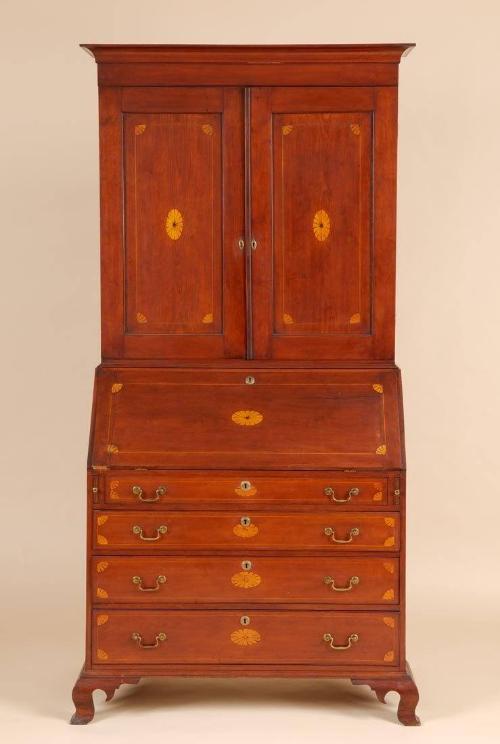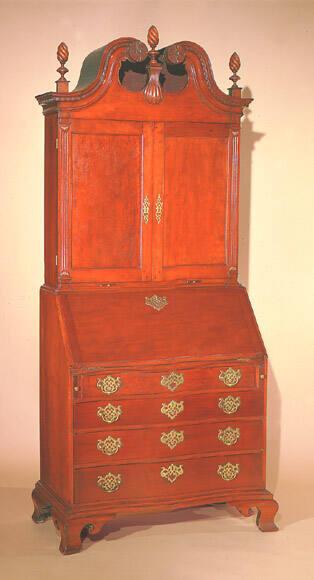Desk and Bookcase
Original OwnerPossibly originally owned by the
Norman Merrill family
(American)
Furniture MakerMade by
Unknown
Date1800-1815
MediumCherry primary wood, eastern white pine and tulip poplar secondary wood, brass hardware
DimensionsPrimary Dimensions (overall height x width x depth): 83 3/4 x 42 3/4 x 21in. (212.7 x 108.6 x 53.3cm)
ClassificationsFurniture
Credit LineBequest of George Dudley Seymour
Object number1945.1.1097
DescriptionCherry desk and bookcase with a flat top in the Federal, or neoclassical, style. The desk and bookcase consists of a bookcase in the upper case, over a slant-front desk in the lower case. The cornice, the uppermost portion of the bookcase, has deep cove molding on the front and sides. Each bookcase door has a patera, or light wood inlay, consisting of an oval in the center of a vertically-oriented rectangle with quarter-circles at each corner; the inlay has burnt edges. The mid-molding is nailed to the bottom of the bookcase, and the bookcase sits over the desk. The slant-front has a light wood inlay, consisting of an oval in the center of a horizontally-oriented rectangle with quarter-circles at each corner; the inlay has burnt edges. The desk arrangement consists of a slant front above four graduated drawers. The top drawer is slightly narrower than the others and is flanked by a loper, or thin board that pulls out to form a support for the slant front when open. The drawer fronts have a light wood inlay that matches that of the slant front. Each ogee bracket foot has a spur on the knee bracket return.
The interior arrangement of the bookcase consists of one full-width, fixed shelf. The interior arrangement of the desk includes a center prospect drawer flanked by a vertical panel, two drawers stacked one over the other, and a final square drawer. Below this are nine pigeonholes in a line; the valance at the top of each pigeonhole has a shaped lower edge, consisting of two hanging half-circles flanked by a semi-circular arch and a hanging quarter circle. The front edge of each vertical partition between the pigeonholes consists of a deep C-scroll that gradually curves down to the surface of the desk. Each vertical panel flanking the prospect drawer forms the front of a concealed drawer. Hardware includes a small, oval brass lock escutcheon on each bookcase door; the left escutcheon is blind. The lower left interior corner of the left bookcase door has a small latch. The slant front of the desk has an oval brass lock escutcheon centered at the top edge. Each interior desk drawer has a small, oval brass pull that projects outward. Each loper has a small brass knob. Each exterior desk drawer has an oval brass lock escutcheon in the center flanked by a brass ring-and-bail pull.
Condition: The corner block for the front right foot has separated from the foot. The lower edges of the drawer sides have been repaired. The drawer runners are replaced; new drawer runners have been installed with screws. The hardware is replaced.
Design and Construction Details:
Design. The inlay has burnt edges creating an abstract floral design inside the ovals; all of the ovals have an even number of partitions, ranging from ten to fourteen. The ovals on the graduated drawers change size in relation to the drawer height.
Case Construction. The backboard is nailed into rabbets in the upper and lower case sides. The top is dovetailed to the case sides. The bookcase doors are formed with panel-and-frame construction; a narrow, verical band of molding is applied to the inside edge of the right bookcase drawer. Each interior side of the bookcase has seven grooves, to accommodate adjustable shelves (the only shelf present is fixed into place). The concealed drawers in the desk are accessed by removing the prospect drawer and pushing the drawers out through a notch in the back of each vertical partition that separates the concealed drawers from the prospect drawer. Felt is applied to the top of the lopers. The desk rests on a three-sided frame, which forms the base molding at the front and sides. The foot blocks with ogee facing are applied to the underside of the three-sided frame; the rear edges of each back foot are supported by a triangular bracket.
Drawer Construction. The drawer dividers are dovetailed into the sides of the lower case; the dovetails are concealed with facing strips. The drawer runners (replaced) are nailed to the case sides. Each top drawer runner is wide enough to support the loper and one side of the top drawer. The exterior desk drawers have incised molding on all four sides. The tops of the drawer sides are flat. The drawer bottoms slide into a groove in the front and sides of each drawer and are nailed at the back. The interior desk drawers are constructed in the same manner, but they do not have incised molding on the front. The back of each interior desk drawer has glue blocks that act as stoppers. The dovetail pins are small and triangular.
The interior arrangement of the bookcase consists of one full-width, fixed shelf. The interior arrangement of the desk includes a center prospect drawer flanked by a vertical panel, two drawers stacked one over the other, and a final square drawer. Below this are nine pigeonholes in a line; the valance at the top of each pigeonhole has a shaped lower edge, consisting of two hanging half-circles flanked by a semi-circular arch and a hanging quarter circle. The front edge of each vertical partition between the pigeonholes consists of a deep C-scroll that gradually curves down to the surface of the desk. Each vertical panel flanking the prospect drawer forms the front of a concealed drawer. Hardware includes a small, oval brass lock escutcheon on each bookcase door; the left escutcheon is blind. The lower left interior corner of the left bookcase door has a small latch. The slant front of the desk has an oval brass lock escutcheon centered at the top edge. Each interior desk drawer has a small, oval brass pull that projects outward. Each loper has a small brass knob. Each exterior desk drawer has an oval brass lock escutcheon in the center flanked by a brass ring-and-bail pull.
Condition: The corner block for the front right foot has separated from the foot. The lower edges of the drawer sides have been repaired. The drawer runners are replaced; new drawer runners have been installed with screws. The hardware is replaced.
Design and Construction Details:
Design. The inlay has burnt edges creating an abstract floral design inside the ovals; all of the ovals have an even number of partitions, ranging from ten to fourteen. The ovals on the graduated drawers change size in relation to the drawer height.
Case Construction. The backboard is nailed into rabbets in the upper and lower case sides. The top is dovetailed to the case sides. The bookcase doors are formed with panel-and-frame construction; a narrow, verical band of molding is applied to the inside edge of the right bookcase drawer. Each interior side of the bookcase has seven grooves, to accommodate adjustable shelves (the only shelf present is fixed into place). The concealed drawers in the desk are accessed by removing the prospect drawer and pushing the drawers out through a notch in the back of each vertical partition that separates the concealed drawers from the prospect drawer. Felt is applied to the top of the lopers. The desk rests on a three-sided frame, which forms the base molding at the front and sides. The foot blocks with ogee facing are applied to the underside of the three-sided frame; the rear edges of each back foot are supported by a triangular bracket.
Drawer Construction. The drawer dividers are dovetailed into the sides of the lower case; the dovetails are concealed with facing strips. The drawer runners (replaced) are nailed to the case sides. Each top drawer runner is wide enough to support the loper and one side of the top drawer. The exterior desk drawers have incised molding on all four sides. The tops of the drawer sides are flat. The drawer bottoms slide into a groove in the front and sides of each drawer and are nailed at the back. The interior desk drawers are constructed in the same manner, but they do not have incised molding on the front. The back of each interior desk drawer has glue blocks that act as stoppers. The dovetail pins are small and triangular.
Status
Not on view











